#imagine a pandemic that targets people like you
Explore tagged Tumblr posts
Text
Sometimes something puts me into my context as a queer born in the 80s and growing up in Section 28 England, and there's nothing else really to do except have a little cry about it.
“There’s a generation of queer people grieving for the childhood they never had,” Haigh says. “I think there’s a sense of nostalgia for something we never got, because we were so tormented. It feels close to grief. It dissipates, but it’s always there."
#queer#i was too small to know it was going on#and by the time i was old enough to understand it was too late#when i try to imagine a childhood without anti-queer and anti-trans violence as a cultural influence i just go totally numb and empty#like flipping a switch#you've all had a pandemic now right#imagine a pandemic that targets identity#imagine a pandemic that targets people like you#if you catch it you will die a slow and painful death and infect the people you love the most#and everyone else thinks that it's killing you because you are you#and 75% of the population thinks who you are is an abomination#and so no one cares that you're all dying#and then imagine that instead of it happening to you as an adult who can process that. it's happening to you as you develop a sense of self
51 notes
·
View notes
Text
The Test, chapter 4
Jack opened his eyes slowly, feeling a familiar weight on his chest. He was lying on a metal stretcher, his hands and feet firmly strapped with leather restraints, immobilizing him. The air in the room was heavy, oppressive, and the darkness was only interrupted by the glow of the machines around him. Beside him, a monitor displayed a real-time electrocardiogram and echocardiogram. The image of his heart, enlarged from prior testing, beat with a steady, powerful rhythm on the screen. The beats felt deeper, stronger, as if his heart had evolved after the tortures it had endured.
For a moment, Jack found himself fascinated. Despite the fear, pain, and suffering, he couldn’t stop staring at the screen that projected his own heart. The organ looked strong, robust, even after everything it had been through. But that fascination was soon replaced by a disturbing question: What would Dr. Ruiz do next?
Suddenly, Ruiz's voice echoed through the room via a microphone, clinical and calculating in tone. "Jack, I see you’re awake. I assume you remember that your heart started beating again after ten minutes of resuscitation. It was a challenge, but your heart is... fascinating. Resilient. However, this is far from over. The real test begins now."
Before Jack could process the doctor’s words, the atmosphere in the room began to change. The temperature rose rapidly, turning the room into a stifling oven. The air, already heavy, became almost impossible to breathe. Jack tried to gasp for air, but there wasn’t enough oxygen. Instead, a pink gas began to seep into the room.
"That gas you’re breathing, Jack," Ruiz continued, his voice terrifyingly cold, "is a bacteria designed to attack the heart at a structural level. Its goal is to degrade it, break the fibers, and weaken the muscle from within. If your heart doesn’t deteriorate during absorption, it will mean it’s immune... that your heart is, essentially, perfect. But if it’s not… this is the beginning of the end for you."
Jack felt his mind clouding as a memory surfaced. There had been a pandemic, many years ago, that ravaged the world—a disease that specifically targeted people’s hearts. Now he understood: that disease hadn’t been an accident. Was this part of some larger plan? Had they created the bacteria now infiltrating his body?
As his thoughts spiraled, he felt the gas brush against his feet. The cold touch of the gas, in contrast to the stifling heat, sent a shiver through him. Jack tried to resist, but it was impossible. The gas seeped into his nose, slowly invading his body. He could feel it filling his lungs and spreading through his system. A deep fear consumed him as he imagined what the bacteria would do inside him.
With his heart pounding faster, he turned his head toward the monitor. The echocardiogram showed an acceleration in his heartbeat. Faster and faster. Fear consumed him, yet strangely, his body showed no other symptoms. His heart, though agitated, kept pumping strongly, resisting the attack.
Thirty minutes passed. Jack continued watching the screen, expecting something catastrophic to happen. Each beat echoed in his ears, the only sound in the silent, oppressive room. But, surprisingly, his heart showed no signs of weakening. The pain he had feared never came. There was only the quickened pulse and the growing fear, but physically, he was fine.
Sweat dripped down his forehead, and his breathing, though rapid, remained regular. The pink gas kept filling the room, but his body resisted. Could it be true? Could his heart be immune, as Ruiz had hinted? Was it… perfect?
Note: after publishing this story, I'm planning to write another dark cardiophile novel here, but I would like to make a casting for the characters hearts. So, if you are a male cardiophile, you can send me by dm your EKG, Echo, Heartscans, your heartbeats, etc. And also, like a plus, photos of your male soles 😁 I'll give You credits.

#male heart#gay heartbeat#male cardiophilia#echocardiogram#beating heart#heartbeat#dark cardiophilia#gay men#cpr resus#male heartbeat#male soles
57 notes
·
View notes
Note
I enjoy reading your opinions and rants about how fandom evolution, the repackaging of purity culture, and the social media landscape has created some questionable and awful behaviors amongst readers.
Maybe it's because I'm a newish(?) follower, but I haven't seen many posts of how the same factors affect fandom authors. (This isn't targeted towards you, but more so general fandom spaces, so to speak). I respect your opinion, so I'll just ask.
1. What behaviors that you see other fandom writers do that gets under your skin? 2. Any thoughts on the social-mediafiction on fanfiction culture as whole? I would appreciate your thoughts on this.
Thanks in advance, Vox!
I'm glad you enjoy my ramblings ❤
I don't tend to get into these discussions often, mostly because of a lack of time and energy, but sometimes, some post or event really gets me going—and they come in clusters a lot of the time. I have talked a bit about author behaviors too, but I think most of those posts are quite old—as in, pre-pandemic for the most part, with a few scattered across the last two years or so. They were largely related to bigger discussions on other, fandom-focused blogs I follow.
Re your questions, I can answer them as one because people treating fanfic sites, especially Ao3, like social media and/or hustle culture is my main pet peeve with fic authors.
At the center of it is monetization. That grinds my gears like nothing else. I'm not talking about authors having a tip jar on their blog or someone in a desperate situation taking commissions. But there's this increasing tendency to turn writing fic into a career, not by shifting to original fiction but by monetizing fic itself, and I view that as being fundamentally antithetical to fandom culture. Online fandom is a gift economy—a free exchange of passion, to put a pretty spin on it. That's both one of its defining features and most appealing aspects. There's no barrier to entry, aside from possessing a functional internet connection. Your age, geographical location, financial status, or any such factor doesn't affect whether or not you can participate in fandom, as a reader or a writer (or an artist in general, save for money-intensive stuff like cosplay). Monetization puts a rather sizeable wrench in that, especially when it comes to practices like posting a few chapters for free and putting the rest on Patreon.
Also, frankly, money changes things. All those issues I've talked about regarding entitlement and purity culture will be compounded when there are financial incentives to writing and posting fanfiction. You already have people who think fic writers exist to cater to them personally; now, imagine how people like that would act toward someone they've given money to, whether it's a systematic plan like Patreon or something more voluntary like tipping. Yes, the majority of people who pay writers aren't like this, just like the majority of fic readers in general are lovely people. But we've all also seen the damage that small toxic minority can do. Similar principles apply in relation to purity culture. People are already shit-scared of writing "problematic" topics because there might be witch hunts and doxxing; if they become reliant on fandom as a source of income, creativity will be further stifled (and sanity will probably go further downhill, let's be real). This is already an issue with original publishing, and I'm only in the periphery of those discussions.
Clout-chasing and comparison are two another issues that already exist in fandom and will be worsened when money's in the equation. Venture into r/Ao3 or r/Fanfiction, or any such space for discussing and venting about fandom and especially fics, and you'll find no shortage of people who are angry, sad, discouraged, disillusioned, or otherwise upset about getting less engagement than others in the fandom. To be clear, I'm not denigrating anyone for being sad about posting into the void in general; I'm talking specifically about the disappointment and jealousy arising from comparison. If "I only got X kudos even though Author A got XX kudos for posting the same trope" becomes "I only got X dollars even though Author A got XX dollars for posting the same trope," I'm going to yeet myself into the sun.
And this is the tip of the iceberg. I'm brushing very briefly (hah) on the impact growing monetization can have (and is having) on fandom's social dynamics alone. The legal grey area is a whole other beast. The ethics can be a debate of its own. The specific matter of people posting Patreon and Ko-fi links on Ao3—a volunteer-run, fan-funded platform that explicitly disallows monetization for both legal and social reasons—and then whining when they get penalized could be its own essay. I've seen motherfuckers straight-up argue that Ao3 is taking away their right to profit from their labor.
Seriously, I could talk about this forever. I have bouncing thoughts on specific aspects, from the proliferation of for-profit digital zines to the treatment of one's fic readers as future book buyers, but this post is already too long. I also have pet peeves regarding author behaviors unconnected to monetization, though those are also mostly related to clout-chasing and competitiveness and other nonsense that treats being a fic writer as akin to being an #influencer. Plus, there's no clean split between authors and readers in fandom, so a lot of the stuff I've said about readers being dicks generally arises from fellow writers.
Okay, shutting up now 🤐
TL;DR: Treating fandom like social media or a source of income is a bad idea. Don't do that.
21 notes
·
View notes
Text
Tolkien Black headcanons !!!!!!
Tw for multiple mentions of getting shot
Non-binary + romantically attracted to girls (based on Tupperware character description), pronouns - he/they
A bit of a Math+physics nerd + one of the best students in class (Cartman canonically cheats off of them on tests sometimes)
Has a really healthy and wholesome relationship with their parents + they sometimes either intentionally or unintentionally embarrass him in front of his friends but all in good fun (think of Ninjago Jay's relationship with Ed and Edna for reference)
Bit of a complicated relationship with Nichole (canon but i forgot in which episode it was said, but Nichole told Cartman that she and Tolkien are having some issues in their relationship? But it's not any of Cartmans business) (though he loves her and they even canonically have a picture of them together in his room)
Best friends with Craig, Clyde's a close second
Already mentioned it in my Craig headcanons posts but before Craig got with Tweek he would joke about proposing to Tolkien in the future so he could live off of their and their parents wealth lmao
Most serious/realistic??? out of Craig's gang
Has a bit more goofy / derpy side but is mostly embarrassed by it
Voice cracks in the future come to be the death of him
TW TRAUMA + POLICE BRUTALITY - is still quite distraught from being shot in the arm by a cop (in South ParQ Vaccination Special? Or was it on The Pandemic Special?) and is still distraught from that time his parents were arrested for no reason (in TFBW, where they also constantly targeted him and treated him (a ten year old child) like a threat), especially since most their childhood, like all the other kids, they were told that cops are their friends they can trust! But now he knows he can't trust them and avoids them whenever possible
Friendly
Canonically likes basketball (I like to imagine they sometimes play with Kyle!)
Favorite colour is purple (NO WAYYYY WHO WOULD'VE THOUGHTTTTTT /s)
Canonically feels out of place sometimes because of their family being rich
Sometimes takes the role of "the mom friend" (idk why. based on vibes. screw me)
Cringe TikTok user (canon 😞)
Not too much of a nerd like his dad
Since they actually hate that their name is Tolkien (cuz they don't like JRR Tolkien's books) maybe they change it in the future? I don't know what to though (but sometimes likes Token better)
Kind of understandably tired of everyone's shit
Wendy once said "I've dated him before, he's really nice!" or something like that sooo I take it as canon
Hates Cartman and has every single right to do so (he threw a rock at their head, shot them, and is just a racist asshole all the fucking time to them 😭😭)
But wait - what I don't understand is that they said "all that dungeons and dragons shit is lame" but in the stick of truth (haven't played it, only saw like 2 scenes in it) they were fully on board with playing fantasy? Like -
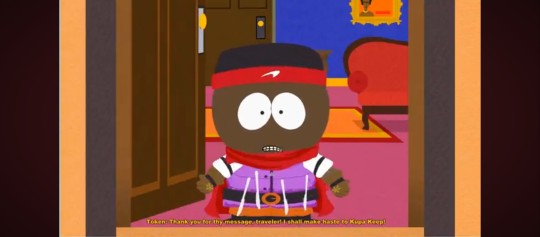
"THANK YOU FOR THY MESSAGE, TRAVELER! I SHALL MAKE HASTE TO KUPA KEEP!" - that sounds pretty nerdy to me Tolkien. Maybe they DO like nerdy shit but are just embarrassed to be associated with it???????? Idk I'm starting to get confused. Tolkien hyper fans / analysts if you're out there please help me
Canonically plays bass and still has his bass guitar in his room as shown in TFBW
Good person that usually puts others before themselves (like when Cartman told him to "be the bigger person" and tricked him into going over to him and getting shot by him)(still stands his ground and doesn't let people walk over him)
On southparkstudios.com it was said they're good friends with kenny and share struggles related to income (opposite sides of the same coin) so maybe they hang out sometimes. that'd be kinda cool.
Cat person I've decided though I don't think he cares too much abt the dogs vs cats debate
Gifted + talented kid but sometimes might be a perfectionist with overtly high expectations for themselves???????? Idfk what I'm on dude
Good memory
Likes to roleplay
Can't tell if he prefers fiction or nonfiction cuz of stick of truth but also because of the whole hating his name thing Eufhfhfuufnceucb
Ermmmm i think that's it for now Byeeeee god im so cringe
#sp#south park#tolkien black#token black#sp tolkien#tolkien sp#south park tolkien#tolkien south park#sp token#token sp#south park token#token south park#tw police#tw gun mention#tw violence#south park headcanons
12 notes
·
View notes
Text
Leftist, antiracist activists like to criticize the police, but something even scarier than police brutality and corruption has been happening in the community near me.
There is a significant portion of the population in suburban Delaware that harbors both deeply racist views, and anti-police sentiment. These people tend to have far-right views and a deeply punitive mindset; Delaware is a "blue state" and has been relatively progressive about its police policies, moving away from overly punitive policing in recent years.
And some people are irate about it. There are social media posts complaining about out of control crime.
This is woefully out-of-touch with what is actually going on. Delaware had a record low rate of violent crime in 2023, following a brief, temporary surge during the pandemic. Delaware has reduced their prison population too. Statewide total crime has also decreased from 2018 through 2022 as reported by the state, with the largest decrease in drug offenses and a relatively smaller decrease in property crime.
People though have started posting stuff on social media with blurry pictures of people from doorbell cameras, dash cams, and other low-quality cameras. Most of the people in the photos are children or young teenagers. Some of them are employees at work just ringing people's doorbells for presumably valid reasons, such as utility workers, county tax assessers, or delivery people. Occasionally people post photos catching people in the act of a crime, like breaking into a car or damaging property.
A lot of the photos are so blurry it would be hard to definitively ID someone from them, and thus easy to mistake someone's identity. And they're sharing these things on social media and calling for a sort of vigilante justice. And predictably, most of the people being targeted are dark-skinned, which is significant because Delaware is overwhelmingly (65%+) non-hispanic white. It's obvious that these posts are tainted by racism.
When a crime is involved, a lot of people suggest to go to the police, but any time the police are brought up, people start trash talking the police. "The police don't do anything". "Cops are useless." and stuff like that. People are really angry and irate and viciously attack anyone who advocates going to the police.
There is this idea that the police do nothing and the only way to deal with crime is to "take things into your own hands". I don't even know what these people want, because they won't come out and say it, but it's really scary. People are talking about circulating people's pictures, calling them "criminals" and that they need to be "punished". Many of these people, from their other posts, are open about owning guns.
When people talk about defunding the police or abolishing the police, I think it's important to ask the question of what will take their place. As corrupt an institution as the police in the US are, I think it's important to remind ourselves that there can be things worse than the police, and that sometimes, in a power vacuum, whatever institution self-organizes may be worse than the one that existed before.
One of my ancestors was killed by lynching in the south, because he was seen as sympathizing with the Union in the civil war. I also have directly experienced harassment in public for being gender-non-conforming, and also a slew of antisemitic hate comments online targeting me because of my Jewish name, and also sometimes because of my political stances.
I know where this leads and it's not good. People like me (and probably you, reading this) are vulnerable. I belong to multiple groups that would be targeted if vigilante violence became a thing.
I'm white, a US citizen, and relatively well-off. I can't even imagine how much more vulnerable black and other dark-skinned people, immigrants, and poor people would be than myself. But I know they are going to be even more vulnerable.
Take from this what you will. I can tell you what my take is:
We as a society have a deep need to root out both racism and the punitive mindset, and achieving these goals is much more than just moving away from formal policing.
Removing the institution of the police while retaining the racism and the punitive mindset risks devolving into a hellscape of vigilante justice shaped by racism and other biases
In the interim, a functional, even if flawed, police system, with some semblance of respecting due process, is a better status quo than a completely broken or absent police in which vigilante justice (with no due process) takes hold
This is why I am hesitant of rhetoric that universally demonizes the police or calls for immediate or full police abolition. A lot of people see police abolition as a leftist take, but as my recent experience shows, this movement may find an unlikely and unhealthy ally in far-right sentiments, and there is a huge danger in allowing these sentiments to take hold.
When elements of abolition (such as decarceration and decriminalization) take hold, it often strengthens far-right anti-police sentiment, because people start seeing the police as allied to the left, which is ironic because the left often still sees the police as allied to the right.
I haven't seen anyone in police abolition circles talking at all about these occurrences, let alone propose any solutions.
If we want to achieve police abolition, we need a path forward that keeps these unsavory elements under control. And I'm struggling to see that path, which is one thing that makes me think we may need to put the brakes on some of the boldest pushes of the abolition movement.
2 notes
·
View notes
Text
'The Role of Influencers in Public Health Messaging: How Social Media Influencers Can Drive Awareness and Change.'
MDA 20009 Digital Communities
Did you know that there are approximately 5.16 billion active social media users worldwide? On average, people spend 2 hours and 23 minutes a day scrolling through their feeds, liking posts and watching videos (Larson, 2024). In today's world, we rely more and more on social media for news, advice and trends. This makes influencers – people who can shape public perceptions and behaviours – some of the most influential voices in public health communications. Global surveys show that younger audiences are turning to social media influencers (SMIs) for information about important issues like health, rather than traditional news outlets (Newman et al., 2023). As public health organisations keep on looking for ways to engage large and more targeted audiences, they're increasingly turning to influencers as key partners. Social media influencers, with their extensive reach and close connections to their followers, can have a big impact on how health information is received, understood, and shared.
Understanding Why Influencers Are Effective in Health Messaging.
In the age of social media, people are often more connected to brands, media, celebrities, and influencer content than to their personal ‘real-world’ networks (Pöyry et al.). Social media platforms like Instagram, TikTok and YouTube use algorithms that show popular and engaging content more frequently, and when you combine that with the followers and appeal of influencers, the impact is huge. Traditional healthcare providers just can't compete on that level.
A key factor in their effectiveness lies in the nature of their relationships with followers. Reinikainen et al. (2020) studied how one-sided 'imagined' relationships between followers and media figures – what we call parasocial relationships – can affect the effectiveness of endorsements. This connection means influencers can share public health messages in a way that feels more personal and friendly, rather than like they're telling people what to do. Unlike traditional experts, influencers gain people's trust through the honesty and reliability of their online presence (Pöyry et al., 2022). This trust can encourage people to take action, especially younger audiences who value authenticity over authority.
Social influence theory further reveals the reasons why influencers are successful in shaping behaviour. The theory suggests that people are influenced by information about desired behaviour and observations of others' behaviour (Kaplan & Miller, 1987; Wood, 2000). Influencers act as opinion leaders in the digital space, setting social norms that prompt followers to adopt. For example, when influencers promote vaccination or fitness, they establish a normative influence that makes these behaviours more socially acceptable and popular among their audience.
In addition, influencers' ability to promote weak ties - the bonds that connect distant social networks - allows them to spread health messages far beyond their immediate follower base (Bakshy et al., 2012). Coupled with the interactive and participatory nature of their content, influencers are well positioned to amplify the impact of health campaigns, reach underserved or hidden audiences, and drive meaningful behaviour change (Pöyry et al., 2022). This combination of personal connection, social influence, and algorithmic visibility gives them a unique role in public health communication.
Case Study: COVID-19 Public Health Messaging
During the COVID-19 pandemic, influencers were key in sharing health info during the pandemic, and Dr Mike Varshavski is a great example, popularly known as "Doctor Mike." He's a licensed doctor and social media influencer with millions of followers on YouTube, Instagram, and TikTok, he effectively bridged the gap between scientific information and the public.
Dr Mike uses his platform to expose misinformation, explain complex health topics such as vaccine efficacy and wearing masks, and share updates on COVID-19 guidelines in an approachable and engaging way. His credibility as a medical expert, coupled with his down-to-earth style, has helped him win over a wide audience, especially younger demographics, who might otherwise stray from traditional health communication channels.
Here are some example videos and short posts by Doctor Mike related to the COIVD-19 pandemic:
youtube
youtube
youtube
Research has shown that during a pandemic, information shared by influencers is more likely to be accepted, especially when it is presented as part of their own life story, struggle or journey. In addition, people tend to be more willing to share such content because of its personal and accessible nature than official government information, which many consider remote or inaccessible.
The Pros and Cons of Influencers in Public Health
Pros: Increasing Awareness and Engagement
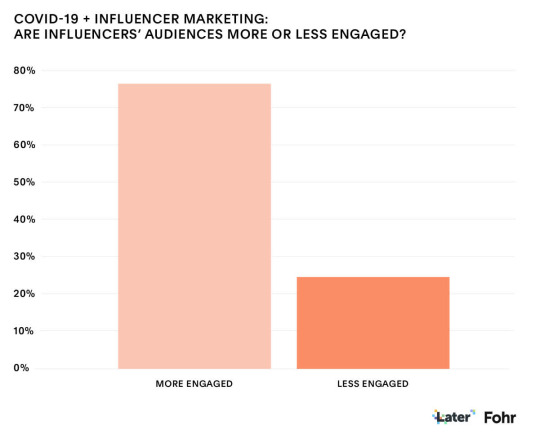
Data shows that influential audiences are more engaged during a pandemic.
Social media platforms are powerful tools for public health because of their broad reach, high engagement levels, and the ability to tailor content to target audiences (Kanchan et al., 2023). Influencers can make health content engaging, accessible and shareable, thereby initiating conversations in online spaces where younger audiences are more active and receptive. Furthermore, influencers' personal connection with followers often makes them more persuasive. As opinion leaders, they have the potential to motivate people to take preventive actions and promote healthy behaviours, whether through fitness routines, mental health tips, or updates on health crises.
Cons: Risks of Misinformation

Report in 2020 shows that Facebook has posed a significant threat to public health.
While influencers have the potential to spread good information, they can also spread misinformation. Some influencers have promoted diets, supplements and health claims that are questionable, unproven or unfounded. For instance, Jenkins et al. (2020) observed how certain influencers, often with large followings, shared damaging fad diets without any consequences, while Leader et al. (2021) explored the spread of anti-vaccine sentiments by influential mothers on social media. A 2021 study by the Centre Against Digital Hate found that 65 per cent of anti-vaccine misinformation on sites such as Facebook and Twitter can be traced back to 12 influencers. These cases show how dangerous it can be when people with a lot of influence don't have their messages checked, as misinformation can spread quickly and endanger public health (Michel et al., 2024).
Conclusion
In summary, social media influencers are pivotal in public health communication, using their broad reach and personal connections with followers to drive awareness and behavioral change. Followers trust influencers as relatable voices, often engaging more actively with their messages than traditional health campaigns. While influencers can amplify accurate health information, they also risk spreading misinformation, as seen with questionable diets or anti-vaccine sentiments.
To maximize their impact, public health organizations must partner with credible influencers, monitor content for accuracy, and provide reliable resources. With responsible collaboration, influencers can effectively engage diverse audiences, combat misinformation, and promote positive health outcomes on a global scale.

Thank you for reading, see you in next post <3
Reference:
Larson, S. (2024, April 8). Social Media Users 2024 (Global Data & Statistics). Priori Data. https://prioridata.com/data/social-media-usage/#:~:text=As%20of%202024%2C%20there%20are%20approximately%205.16%20billion,platform%2C%20with%20over%203.15%20billion%20monthly%20active%20users.
Michel, A. E., Miller, E. S., Singh, P., Schulz, G., & Limaye, R. J. (2024). The Emerging Landscape of social media Influencers in Public Health Collaborations: A scoping review. Health Promotion Practice. https://doi.org/10.1177/15248399241258442
Pöyry, E., Reinikainen, H., & Luoma-Aho, V. (2022). The role of social media influencers in public health communication: Case COVID-19 pandemic. International Journal of Strategic Communication, 16(3), 469–484. https://doi.org/10.1080/1553118x.2022.2042694
6 notes
·
View notes
Text
Look, I don’t think any of us can ever truly comprehend the horror, the scale of devastation happening in Gaza right now. We all know the number of deaths is huge (more than 40,000 right now), but I don’t think we can ever truly understand the scale of it. The number of asks in my inbox (383 right now, not counting the dms) reminds me of it daily, and lately it has also been reminding me of the first time I truly realized the huge scale of the suffering in Gaza, how great the number of deaths exactly is.
On June 11, the known number of deaths was 37,164. My uni’s Palestine solidarity encampment had decided to read all the known names of Palestinian martyrs since 7 Oct 2023 in front of a uni building on a street busy with tourists. At lest 16,694 of their names were still unknown. It took our Arabic speakers 25 hours of non-stop reading to read out all the known names (20,470). And that’s just people whose names are known!
I happened to have a meeting with my Department that day (also regarding Palestine), and with all the pre-meetings and debriefing, I only managed to arrive in the afternoon, when they had already been reading the names for 8 or 9 hours by then. My friend who was organizing this protest, she was sitting there along with a few other people, trying to write all the known names on ribbons. I knew she had likely been there since the beginning, so I offered to help. She handed me the thickest binder I had ever seen, thicker than my fist, filled with A4 papers with the names of the dead. I felt my heart clenched as I looked at the thick binder, it was so thick.
“All these pieces of paper in the binder, they are all names of the dead?” I asked her.
“That’s not our only binder,” she said, pointing to the binder our speaker was reading from. A binder that was just as thick.
I can’t remember now if there was a third binder.
They had arranged the names of the dead according to their age. She was on page 273, which listed the names of 20-year-old Palestinians who had been killed. I still had about 4 more pages to go before reaching the names of the 21-year-olds. We were on page 273, and we were still only on the names of 20-year-olds.
(I tried to remember what I was doing at 20. I was on my second year of uni. I just had my first breakup and my first heartbreak. I was complaining about having to attend lectures of Zoom due to the pandemic. I tried to imagine what it would be like if my life had ended then, when I was 20 years old)
Think of how many more have died since then. Remember how in these conflict situations, the death toll is almost always higher than the official number given the difficulty of counting the dead.
I’m not really sure why I’m telling you all this. I’m guessing with all the Palestinians reaching out regarding their gfm campaigns, I just want to remind myself and everyone else that what we can see is just the tip of the iceberg of the devastation happening in Gaza. That we are in a very privileged position and that we can never truly comprehend the scale of suffering in Gaza. So please be kind. Mourn and remember the dead, but never stop doing our duty to the living. I now invite you to donate to at least one of their campaigns, and read and share at least three of the campaigns and their stories, especially if you are going to reblog this post. Please do not let this post overshadow the Palestinians asking you to read their stories and help them. Please, I know you can do this.
As you may know, I am spotlighting Hazem’s campaign at the moment.
Hazem Khalil
Please take time read Hazem’s story on his Tumblr account: @hazempalestine
Donate to Hazem’s family here: https://gofund.me/5977f50b
Currently €12,804 raised of €50,000 target.
Hazem is from Gaza but he moved to Belgium in 2018 for his studies. Since then, he has not been able to see his family in Northern Gaza. The area his family is staying at was recently bombed, and he had lost contact with them while it was happening. He was messaging me about it and he was really scared for his family. Luckily they survived and he managed to reach them eventually, but it was a really close call. He is trying to raise funds to evacuate his 7 family members (his parents, four brothers, and his sister).
I am also organizing this handmade bracelet raffle in order to raise funds for Hazem's family (UK only). See post here
Some other campaigns I would like to especially share here:
Dr Husam Farhat
Please take the time to read Dr Husam Farhat’s story on his Tumblr account: @husamfarht, @nedataya, @frhatfamily, @drfarhatblog, @shamfarhat1
Please donate to Dr Farhat’s campaign here: https://gofund.me/4b28130c
Currently $5,285 USD raised of $29,500 target.
Dr Husam Farhat has suffered the loss of many family members. His sisters Inas and Amal, along with their husbands and children, as well as his brother Mustafa, they have all been killed in a bombing. He has a wife and two sons, but their house has also been destroyed, as well as his office which was his source of income. Husam is also a PhD candidate, and has taught at several universities, but now he is faced with an uncertain future. He and his family has been displaced nine times, and they are trying to evacuate out of Gaza.
Bshaer and Intisar Abu Shamaleh
Please take the time to read Bshaer’s story here: @bshaeromars-blog
Please donate to Bshaer and Intisar’s campaign here: https://gofund.me/74e87f75
Currently $14,986 USD raised of $40,000 goal.
Bshaer was pregnant with her first child when the current genocide happened. Her husband Omar was killed in December by an airstrike when he was collecting fire wood for the family. Bshaer is now a widow and her daughter Ayla, born three months ago, will never get to meet her father. Aya faces a lot of health risks since she is unvaccinated. Bshaer also has 6 siblings. Intisar, Bshaer’s mother, is trying to provide for Ayla, and she is raising money to evacuate them out of Gaza.
Amjad Sido
Please take time to read Amjad’s story here on his Tumblr account: @amjadsido99, @amjadsido
Please donate to Amjad’s campaign here: https://gofund.me/0729ac5b
Currently €6,461 raised of €30,000 target.
Amjad has 2 children (Mosbah (6) and Abdul Rahman (3)). Mosbah had just graduated kindergarten. Amjad is also living with his mother and 5 brothers. The occupation has destroyed their house and killed his father and two of his brothers. Amjad and his children would have been killed too if they had not left the house at that moment. They are now displaced. And instead of continuing their education, his young children are helping him light firewood to prepare food. Amjad is also caring for his nephew as his nephew’s father had been killed. They are trying to evacuate out of Gaza.
Click here for my Google Doc with my complete masterlist of all the Palestinian gfm asks I've received, updated daily (along with other verified ways to send aid to Gaza). I encourage you to read more of their stories, share them, and donate to their campaigns.
Thank you
#free gaza#palestine#gaza#gaza genocide#free palestine#donations#fundraising#gaza fundraiser#palestine fundraiser#vetted#encampment stories#student encampment#palestine solidarity encampment#gaza gofundme#palestine gofundme#gaza gfm#palestine gfm
5 notes
·
View notes
Note
Would you say that cataclysms or crises, like market crashes, wars, elections, pandemics, have their own spirits? Or put it another way, these things are not just chains of events, but separate energetic entities that initiate or guide the proceedings on the ground? If yes, would, erm, plinking spells at them with intention to get rid of them just make these constructs pay more of their... let's say transformative attention to a particularly daring spellcaster?
This is really interesting!
I hesitate to say that casting a spell at a market crash would make the spirit of the market crash rise up to harm you.
And I am 100% just basing this off of the fact that it sounds silly to me. Very much overlapping on conspiratorial, even.
Also I've never heard of it happening. And it doesn't line up with the way I think the world works.
For this to work, I think we have to believe 3 separate things:
All major national or global crises either are spirits in and of themselves, or are all guided and guarded by spirits (hereafter called Crisis Spirit).
A Crises Spirit (whether that be singular or a cohort has little relevance I think) would (A) notice energy directed against it, and (B) be capable of retaliation.
If it takes enough notice against any single person or working group, the Crises Spirit would choose to carry out targeted retaliation.
I do not believe that all catastrophes are, or are guided by, spirits. Not even the very big catastrophes. It's tempting to think that there is an organized malevolent force behind everything bad happening, but at this point we're basically talking about the New World Order except we're switching out key words for woowoo talk. So it's a big ask for me to buy into this line of thinking.
As a practitioner, I believe that if you look for a spirit, you'll find it. It's very easy to interpret a big lump of energy as a spirit, and depending on what your definition of "spirit" is, you're never going to not find a spirit.
Crises having their own energy: Yes
That energy automatically being a sentient being capable of awareness and retaliation: No
Even if we say that perhaps these events themselves are not spirits, but are guided by external Crises Spirits, I'm again stymied by the fact that we do not live in a good-vs-evil universe that specifically targets and harms people who try to stop bad things from happening.
Because the problem with this line of thinking is that anyone who wants to help the world then puts themselves in a position of a targeted martyr with access to hidden knowledge that gives them the ability to fight against organized, secret evil at the highest levels of control, and at that point just hang a Q on it.
So my main problem with this is the worldview. As in, damn, imagine the kinds of people you'd be aligning your worldview to in order to have to believe that this happens.
When a person begins their magical practice, I think they probably do rely a lot on what they're told by others. This is baggage. As in, a starting suitcase you need to begin your travels.
After a while, a practitioner begins to get a feel for how things really are beyond what they've been told. They have encounters. They get into situations. They go places. This is experience.
And beyond black pepper and Spells Georg, when a person really starts to make their path their own, I think that a big aspect to this is sorting through what baggage you no longer need, cleaning out the suitcase, and packing new luggage. This shift, I believe, should be inspired by and conform to personal experience.
On the one hand, I keep an active eye out for this type of thinking and do my best to not let it sneak into my suitcase. This is because worldview is a choice; you can choose how you align and orient yourself in this world, the results of which dictate your view. Yes?
On the other hand, I've never seen or experienced what you're describing in the real world and I simply don't believe it exists. My experience of the metaphysical, the spirit world, and magic, precludes there being universally present Crises Spirits that govern all world cataclysms.
This isn't to say that I don't believe spirits can make bad things happen or be involved in bad things. This isn't to say I don't believe there are gods of strife or chaos.
I just don't think there's a cabal of spirits who cause global catastrophe and that might retaliate against you if you try to stop bad things from happening.
15 notes
·
View notes
Text
by Dr. Phyllis Chesler
Hamas has perpetrated a depraved pogrom. There is no other kind. This is what a pogrom looks like and what a pogrom does. The pogromchiki target civilians, the most vulnerable of civilians, and do their worst. They rape Jewish women, torture Jewish men, brutally attack children and the elderly, and then kill them—and anyone who is living with them.
Hamas took a page from ISIS’s Caliphate playbook and video’ed their atrocities in live-time in order to sow further terror (or horribly enough, gladness) in the eyes of viewers. Hamas has also raped and kidnapped women, perhaps into sex slavery, as ISIS also did.
Right away, I started emailing people and saying that this attack was far bigger than 9/11. Here’s why. In terms of demographic equivalence, the Israeli population is a bit more than nine (9) million people; the American population is a bit more than 331 million. Eight hundred (800) Israeli dead and counting is the equivalent of 29,418 American deaths. This is nearly ten times more than the 9/11 number of a little more than 3000. The number of Israeli wounded is, so far, at 2000 and counting. In American terms this is equivalent to 75,503 wounded.
Imagine if America had been told not to respond, not to retaliate, to retaliate but only a little bit to Al-Qaeda’s blow against the Zionist and Crusader entity. Bin Laden said so himself.
A handful of us knew, we knew for a long time, that the pandemic of anti-Israel/anti-Zionist propaganda was inevitably going to lead to what we’ve just seen and what Israel has just endured. Words do harm. Pogroms and genocide have always been the result. This has been the case in the Arab Muslim world and in the European Christian world.
In the early 21st century, I wrote that anti-Zionism was the new anti-semitism and that the alliance between Islamists who hate Jews, Judaism, and the Jewish state for religious reasons far more than for questions of territory—and the western politically correct elites, was the most dangerous kind of alliance. For this, I was denounced as a traitor. Laughed at. Dis-invited. Deemed an Islamophobe and a…Zionist.
Poisoned propaganda has slowly and carefully been sewn into every conceivable fabric of humanity, in every language, round-the-clock. The propaganda is now a tsunami, a cognitive mushroom cloud of death.
The Big Lies are coming at us from the academy, the gliterrati, the United Nations, human rights groups, feminist groups, street activists, government leaders. The hatred for Jews and for the Jewish state is global.
Demonstrations and statements in support of Hamas’s horrific pogrom are taking place world-wide. They have been going on for decades and may not stop anytime soon. Yes, there are also pro-Israel statements and demonstrations going on as well, including the EU, Germany, and Austria’s decision to suspend funding to Palestine. Number 10 Downing Street and the Brandenburg Gate was draped in the colors of the Israeli flag.
But really, there is no comparison, no moral equivalence between the two kinds of statements. Rallying for Israel is rallying for the real victim. Do people know that the head of Hamas, Ismail Haniya’s daughter was treated for free in an Israeli hospital for a month? Doesn’t sound like an apartheid nation state, does it?
Rallying for Hamas is applauding Nazi-like barbarians and the atrocities they commit. I wonder why so many pro-Hamas women are wearing hijab given that Iran, their paymaster, is raping, beating, and murdering Iranian girls and women if their hijab slips or is missing entirely.
Burning questions and difficult solutions remain before us.
I have been monitoring the situation, passing along information to the right people, and have not had the time to sit down and write a long analysis about this War. I will send around a video of a speech I delivered on September 21st via Zoom. I also strongly recommend that you read Liel Leibowitz and separately, Alana Newhouse at Tablet.
I dashed this piece off because a number of people have called and written to me wondering why I’ve been silent. Well—I’ve been covering this shocking, heartbreaking, truly awful War.
12 notes
·
View notes
Text
The first 'conspiracy theory' here is true, what else?
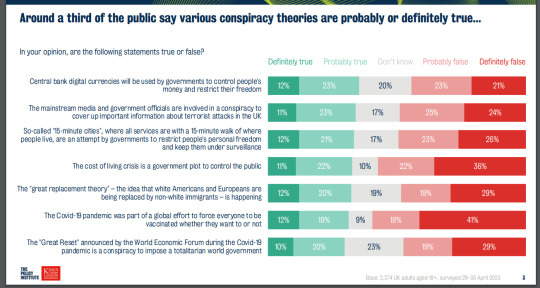
This one is from The Policy Institute of King's College London.
Statement 1: "Central bank digital currencies will be used by governments to control people's money and restrict their freedom"
One-third of people think this is definitely or probably true. The talking heads sneeringly and contemptuously imply it is false, and a conspiracy theory. The one-third of people are entirely correct. The statement is plainly true. Central banks are already used by governments to control people's money and restrict their freedom, there is no reason to believe governments will do an about-face when given a technical advance that provides more control.
For the forty percent of normies who think it's false, I imagine that most of them skimmed the question and heard something like "Government bad with money? true or false".
For the people at The Policy Institute, I think a permanent ban from public communication is in order. The misinformation is once again coming from inside the God-damned house of the professional informationists and the academic-industrial complex.
Statement 2: "The mainstream media and government officials are involved in a conspiracy to cover up important information about terrorist attacks in the UK"
This is plausible. A few years ago, I observed that the mainstream media and government officials had been involved in a conspiracy to cover up important information about gang rapes and slave rings in the UK.
Rotherham is the headline name here, where Pakistani rapist-slavers went around kidnapping, raping, enslaving, and trafficking white English girls, and the white victims were targeted partly because they were white and had less ethnic solidarity and less government protection, while the media told themselves "we don't want to cause a racist backlash" and downplayed the story partly because the offenders were brown. There were lots of cases similar to Rotherham across the UK.
Now, since the statement posits a coverup, it's hard to know with certainty. It's probably true, but I don't know. Anyone answering definitely false is wrong, though. Gullibility points for you, sir! And the people at The Policy Institute sneering 'conspiracy theory' again - the term is hardly more than a slur - I suggest punitive damages in the manner of Xerxes. Ask them how they want misinformers to be punished in a thinly veiled hypothetical of their own situation, then do that to them.
I don't know about 15-minute cities, so I'll skip ahead.
Statement 5: "The "great replacement theory" – the idea that white Americans and Europeans are being replaced by non-white immigrants – is happening"
This statement seems to load a lot on unstated connotations and other definitions of great replacement theory that the polled people won't necessarily have access to. For the summary definition given here, it appears to be true.
White Americans and Europeans have below-replacement fertility rates while their rulers are importing millions of non-whites and seek to import millions more non-whites. This is a deliberate if shortsighted government decision to keep the total population up (allegedly for purposes such as paying pensions) by importation of foreigners instead of by reversing the native decline.
How much difference between this and statement 5 is there, without having to lean on "not what I meant"?
Fuck'em.
Statement 6: "The Covid-19 pandemic was part of a global effort to force everyone to be vaccinated whether they want to or not"
Whomigonna believe, The Policy Institute or my lying eyes?
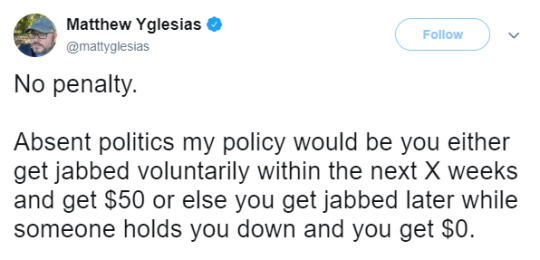
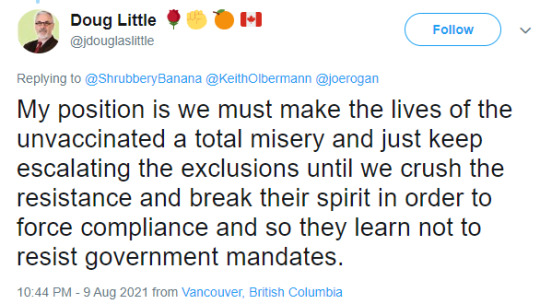
There was a global effort to force everyone to be vaccinated whether they want to or not, caused by COVID-19. It was an unpopular minority effort and it failed, but there was an effort.
The statement as given in The Policy Institute's own material is true.
Perhaps the Institutionals have an implicit mental reservation about "a majority effort" or "an effort backed by the UN Security Council" or "an effort that nearly succeeded" or some other clause that makes it false. But there's no such clause in the statement as given. The statement as given is true. It is not a conspiracy theory.
I despise these people.
Out of seven so-called [*waggles fingers aggressively*] “conspiracy theories” three are true, one is plausible, and I am exerting mental effort not to update towards the other three because reversed stupidity is not intelligence.
But I gotta say, I have more sympathy now for believers in everything listed and every other “conspiracy” they come across, because reversed malevolence is better aligned than reversed stupidity, and I can see how malevolence might compete with stupidity as an explanation for people at King's College behaving this way.
#all#rectification of names#journalism delenda est#the death of expertise#or perhaps the death of credentialism#rant#damn lies and statistics#longpost
24 notes
·
View notes
Text
Rottmnt things:
Trigger warning for real life events affecting a fictional world.
2020. The year the world was invaded by an alien race. The start of the end of the world. The year the Rottmnt movie takes place (despite its release in 2022). Irl, 2020 was a big year as well.
Covid. Covid-19 hit hard and caused a worldwide pandemic. Now imagine if Covid also affected the rise verse. On top of an Alien invasion, which would take precedence, there’s this virus roaming around. There is no government, hospitals are shutting down, society is collapsing, people are spread out but those who find each other stay together. Close. It’s the best way to survive and the best way for a virus to cultivate.
Covid-19 primarily targeted the older generation, those above 50 and has devastating lasting consequences if you managed to survive. But the apocalypse is THE WORST time to get sick, and with resources dwindling, there would be no attention toward a vaccine, limited amounts of ventilators or materials to actually help if someone got sick. You’d be doomed. And the best way to help would be isolation, not to spread or contaminate. And bam. There goes the older generation, the experienced old men who might’ve fought wars before, who could’ve trained, or brought different kinds of survival instincts to the war effort. Any young adults or teenagers affected by the disease might have lasting consequences that affect how much they can help fight. That shortness of breath would really get to you in a world where you have to stay on the move, or fight for your life, or just having to breath in the hot, dusty air around.
The older generation gets wiped out not just from Krang, but from Covid, leaving the resistance to fall into the hands of children.
Wether or not Splinter might’ve been affected, I’ll leave up to you. He fits the target age range, but his rat genes may effect how the disease affects him, if he gets it at all.
But Covid is skepticism, since it’s a fictional world with mutants. Who even knows if it happened, or even if it was worse.
But there’s another thing. Once again, related to the older/middle generation. 9/11. About a week ago, and maybe it’s still going on, fires in Canada caused thick smoke to fall on New York City. An amount which hadn’t been seen since September 11, 2001. Seeing the pictures from my dad, who was traveling in NYC during this time, it gave very apocalyptic vibes and I myself was inspired to give that atmosphere to Rise.
However, there is another connection. The tallest building in New York. The building The Krang attacked, called Metro Tower in the movie, is the World Trade Center. The building that was set as a replacement for the loss of the twin towers. As a reminder that America is still strong and will not forget, by happenstance is the place the Krang enter from the prison dimension, bringing forth terror and destruction.
Anyone in New York who lived through that, and now through this could be prone to PTSD. The sky, the atmosphere, everything could be effected by the krang attack. The lasting effects to the environment as well, and very likely, worse.
9/11 is likely the reason the name of the building was changed to Metro Tower in the movie. Or, you can take that with a grain of salt.
Of course neither of these things HAVE to have any lasting affect. There is so many other things going on that these may seem insignificant. But I think it’s interesting to imagine, and possibly interesting to add.
#rottmnt#wabbystuffpost#rise of the teenage mutant ninja turtles#tmnt#tw: real life#history effects storytelling#apocalyptic future#it’s the apocalypse but we can still have fun#fanfiction#inspiration#TMNT analysis#but that’s just a theory#analysis#long post#rottmnt bad timeline#real life and fiction#Covid is suddenly not the worst thing that could’ve happened#important events in our lives take the back seat in theirs#food for thought#yum yum#rise of the tmnt
13 notes
·
View notes
Text
How to Ignore More than a Century Worth of Scientific Literature and Make Headline-Grabbing Claims on One of the Deadliest and Exhaustively Studied Pandemics in History Based on Flawed Data and Questionable Analysis
The 1918 influenza pandemic, also erroneously referred to as the “Spanish flu,” has affected up to one billion people—half the world’s population at the time—and has killed an estimated 20–30 million people in the Western World and God-only-knows-how-many people in other countries. Previous and subsequent influenza pandemics usually hit infants and the elderly the hardest. The 1918 influenza pandemic was a weird one because of the atypically high mortality among young adults. The peak mortality rate during the fall wave of the 1918 influenza pandemic in Canada and the USA was 28 years. The death of young adults lowered the average life expectancy in the United States by more than 10 years. Numerous studies have confirmed these findings.
A typical picture illustrating the haunting age peculiarity of this pandemic is shown below.
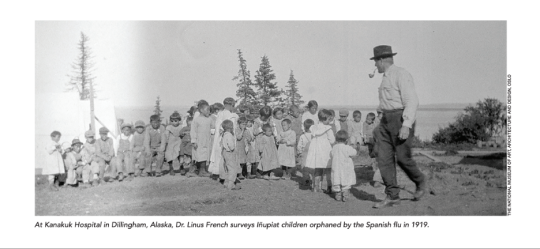
Even in poor, medically underserved communities, it was the young healthy adults that perished leaving many very young orphans behind.
In the early 2000s scientists started looking for samples of the 1918 virus. They reasoned that their best chance was to find it inside an influenza victim buried in permafrost. Brevig Mission in Alaska had 89 inhabitants in 1918 of which 87 died of influenza. It was a good bet that some sequenceable genetic material could be recovered from the graves of these flu victims. Indeed, genomic RNA of the 1918 virus was recovered from frozen lung tissues of an Alaskan influenza victim who was buried in permafrost in November of 1918.
In 2005, scientists used reverse genetics to generate an influenza virus bearing all eight genome segments of the 1918 virus to study its properties. The deadly 1918 virus has thus been resurrected!
The reconstructed virus turned out to be as deadly as the original one with a 100% mortality in mice. Another conclusion of this “resurrection” study was that the virus kills by overreaction of the body’s immune system, which explained the weird age distribution of deaths due to the "Spanish Flu." The strong adaptive immune systems of young adults ravaged their body, whereas the underdeveloped immune systems of young children and the weakened immune system of old people resulted fewer deaths. It was inflammation that killed people, not the viral infection directly or secondary infections. These studies seemed like the end of the 1918 influenza story.
Imagine my surprise, then, when at the end of 2023, I started noticing that the 1918 influenza pandemic is in the news again. “Killer 1918 flu didn't pick on the healthy, after all,” declared Science (the same Science that “killed” Junk DNA a decade earlier). “History Says the 1918 Flu Killed the Young and Healthy. These Bones Say Otherwise,” quipped WIRED. And US News and World Reports headlined the findings as “Contrary to Popular Belief, 1918 Flu Did Not Target the Healthy Young.”
The origin of these headlines was a 2023 paper in Proceedings of the National Academy of Science entitled “Frailty and Survival in the 1918 Influenza Pandemic” by Amanda Wissler, currently an Assistant Professor of Anthropology at McMaster University in Hamilton, Ontario and Sharon DeWitte, Professor of Anthropology at University of Colorado in Boulder. The paper was largely based largely on Wissler’s PhD dissertation at Arizona State University under the supervision of Professor Jane Buikstra.
One would have thought that a study that purports to discard more than a hundred years of observations, refute dozens of analyses, refute the conclusions in about 18,000 peer-reviewed articles, and generate headlines in serious news media would require a great amount of unimpeachable data and an analysis that is—if not infallible—close to infallible. If you thought that, you will be sorely disappointed.
Let us start with the Materials and Methods section. The study is based on a bone sample from the Hamann-Todd Osteological Collection which contains skeletons of people who died in Cleveland, Ohio between 1910 and 1939. The skeletons belong to people whose bodies were not claimed within 36 hours of death (i.e., the poor, the homeless, the socially isolated, the incarcerated, the institutionalized as “mentally defectives,” and those whose relatives couldn’t possibly collect their loved ones’ bodies within a day and a half. Black and indigenous people most probably made the bulk of this collection. Wissler and DeWitte euphemistically called their sample as consisting of “individuals of low socioeconomic status,” who mostly “died in almshouses or public hospitals.” Is this sample representative of the population in Cleveland between 1910 and 1939? I very much doubt it. And don’t even start me on the ethical crimes committed to assemble this collection. Of course, the bodies in this collection were legally obtained following an Ohio legislation that permitted people whose bodies were not claimed within 36 hours of death to be “donated” for scientific study, but was the collection ethically assembled? I think not! The ethics of this collection reminds me of a joke my dad used to tell. “A religious Jewish woman goes to the Rabbi in a panic. ‘Rabbi, the chicken I cooked for Shabbat dinner fell into a soiled baby's diaper. Is it still kosher?’ she asks. The Rabbi replies, ‘It's kosher, of course, but I would I eat it?’” But, I digress.
Wissler and DeWitte’s sample consisted of 369 individuals: 310 males (84%) and 59 females (16%). This fact immediately tells the reader that something is off; the sample is not representative of the general population.
Curiously, the Materials and Methods section also contains the following statement, “to maximize the sample size, both the 1918 flu and the control groups include individuals who died from influenza and pneumonia as well as other diseases such as tuberculosis and myocarditis.” (No data is provided as to how many individuals were included for the purpose of padding the sample size.) Finally, medical history for the individuals in the study is mostly not known. Thus, it is impossible to know whether “an individual suffered another disease during life unless it was listed as the cause of death or left diagnostic evidence on their skeleton.”
Finally, we have the problem of missing data. In the previous paragraph, we have seen one method of padding the data. Here comes another one. The last sentence of the Analytical Methods section states that missing skeletal data “were imputed using the ‘pmm’ function of the mice R package following previous recommendations.” Now, I need to tell the reader that I get hives and homicidal thoughts whenever I read the terms “imputed” or “imputation,” which nowadays essentially mean conjuring data out of thin air. Interestingly, “imputed” was originally a theological term meaning to falsely ascribe guilt to a person. The way data analysts use the word “imputed” started with economists in 1893 when a step in a multistep process was assigned a value by inference from the value of the process to which it contributes. More recently, the term “impute” was used by the Internal Revenue Service to assign interest to an investment when the interest rate is not known. The fact that imputation is used in scientific research to artificially increase the sample size is an inexcusable obscenity.
In the abstract of the article, it is stated that “frail or unhealthy individuals were more likely to die during the pandemic than those who were not frail.” Now, “frailty” is a nebulous and inexact term often defined as “an aging-related syndrome of physiological decline, characterized by marked vulnerability to adverse health outcomes.” https://www.uptodate.com/contents/frailty Thus, the authors used a skeletal proxy to identify frailty. The proxy was lesions on the shinbones (periostosis). Whether this proxy has anything to do with anything is unknown.
The choice of lesions on the shinbones reminds me on of the Streetlight effect or the Drunkard's search principle—both examples of an observational bias whereby one limits the variables used in a study to those that are easy to obtain regardless of whether the choice is actually relevant to the study question.
Let us now discuss the article’s statistical analyses, results, and conclusions. A good piece of advice that I once got from one of my mentors was “Before you subject your data to complicated analyses and reach extravagant conclusions, do yourself a favor and look at the data carefully and perform some simple analyses.” In this case, subjecting the data to complicated (and frankly confusing) Kaplan–Meier survival analysis, Cox proportional hazards analysis, and Schoenfeld test, one should look at the data and do some long division or at most some simple 2×2 contingency analyses.
The following data was extracted from Table 1 of Wissler and DeWitte (2023).
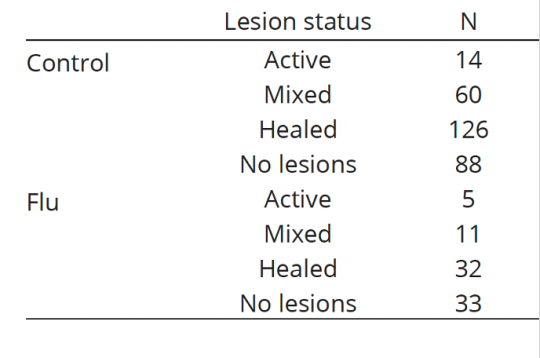
The first thing I noticed was that 67% of the skeletons in the sample belonged to "frail" people. Does this look like a representative sample of the population of Cleveland, Ohio in 1918? The second thing I noticed is that 69% of the control group have had lesions on their shinbones (either active or healed) versus 59% in the group that succumbed to flu. Thus, by the definition used by Wissler and DeWitte, the group of people that succumbed to influenza were 14–17% less “frail” than the group that survived. Of course, in my simple analysis I can use the skeletons exhibiting active or mixed lesions versus the rest of the skeletons (healed and no lesions). In this case, 25% of the control group turn out to be frail, versus 20% in those that succumbed to flu. This result seemed to support the thesis of Wissler and DeWitte, until you realize that the difference is not statistically significant (Fisher's exact test, P = 0.3074).
After reading this paper very carefully, I am left with one open question. It remains unclear to me how this paper managed to get published in PNAS and become a news sensation. Is this another example of the power of the press release?
2 notes
·
View notes
Text
‘For Your Convenience’ (Short Film) #StopAsianHate
Director - Aronjonel Villafor
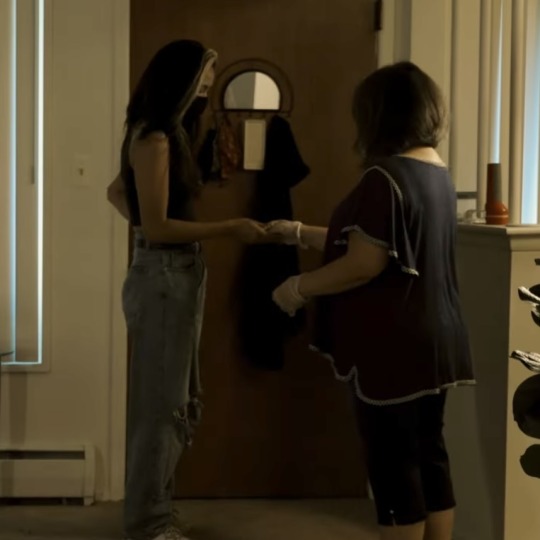
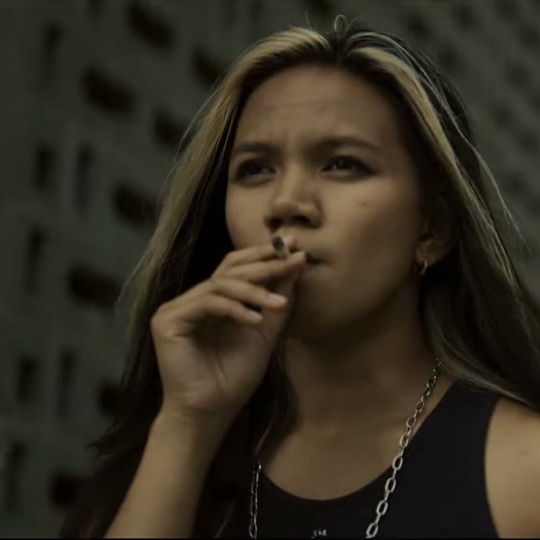
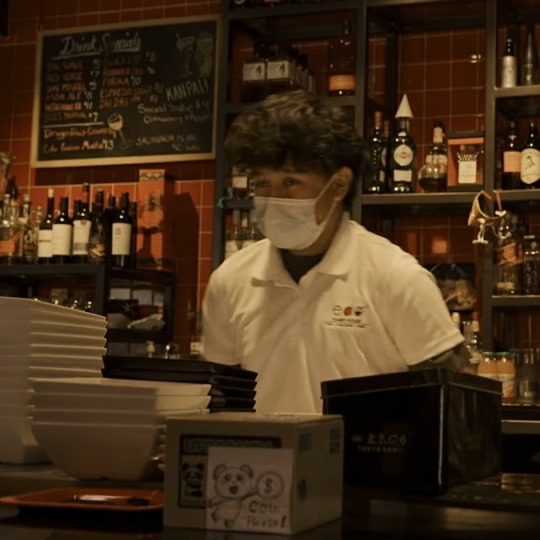
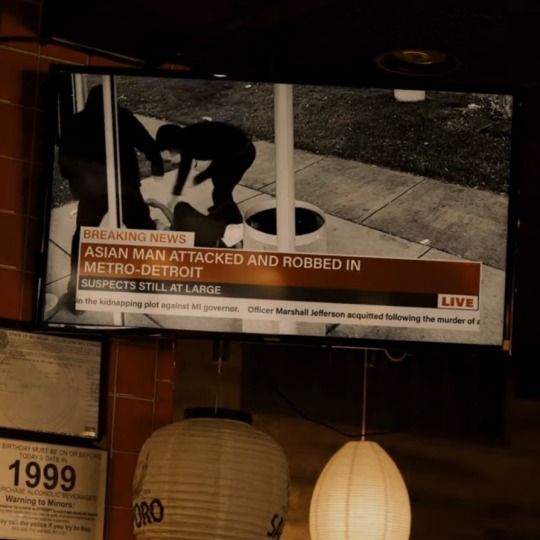
I watched this short film where I found Valladolid doing a great job portraying what life was like for Asian Americans during the pandemic.Within this film it shows the day to day reality, Asians had to face during the coronavirus. They go to work just so they can support themselves,not only is it hard already with how covid changed everything but they also have to deal with seeing people of their own race getting attacked and robbed in public,I can imagine that you constantly have to look over your shoulder because we did not feel safe since Asian people are the prime targets for theses violent attacks.
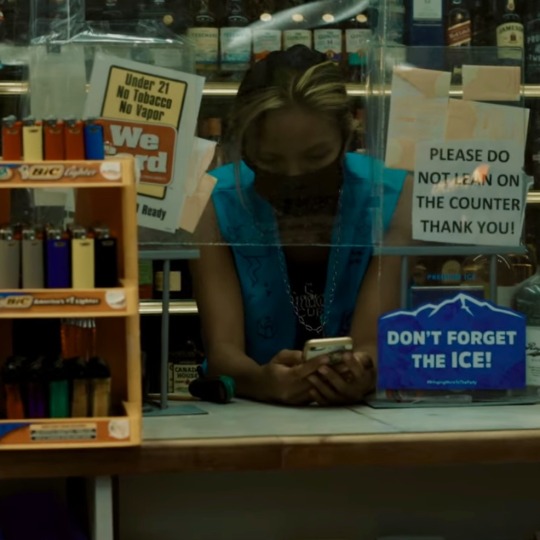

You can imagine that in the film that she’s exhausted. Not only is she having to work to support herself but with these strikes going on it’s getting hard for her to have to deal with hatred where people blame you for the cause of the pandemic.Theres a point in the film where a violent woman refuses to where a mask and begins to act hostile with the worker and starts blaming her why we have to where masks during the “Ching Chong Virus” and further gets violent by throwing products on the ground and yelling “go back to your country”.

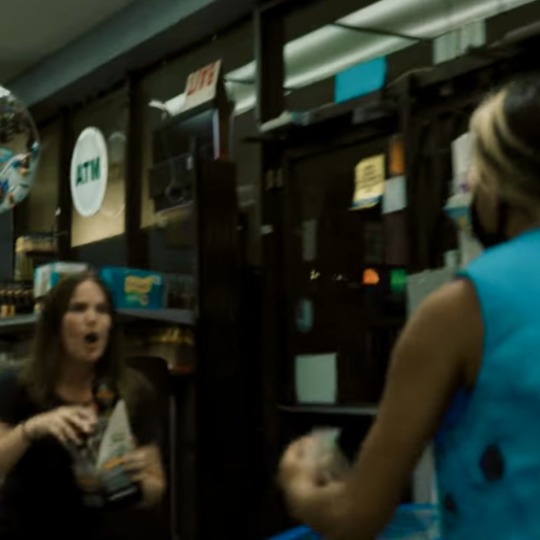
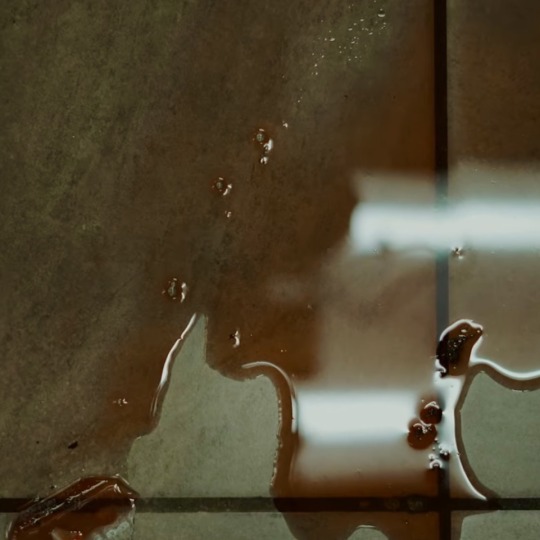
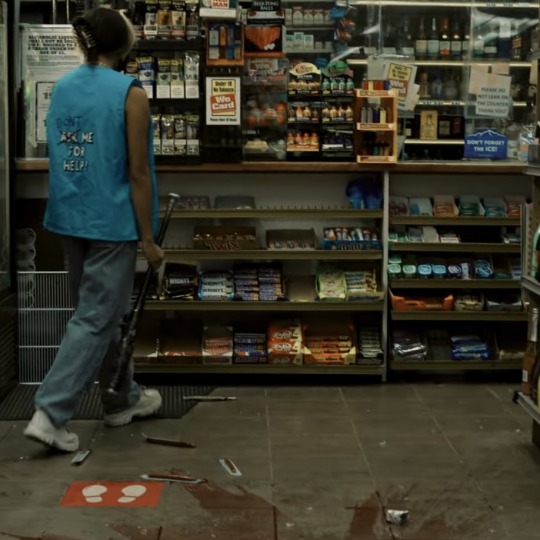
Reason why i chose this short film is because i really like how that in this film conveys the reality of what it was like for the majority of Asian people during the pandemic and i take inspiration by showing the abuse and movements that AAPI had. I want to show the importance of Asian peoples stories during this difficult time and how it impacted us. I can understand it affected many people across the globe but when your looking over your shoulder constantly by making sure you dont get violently attacked you can’t help but deny what Asian People had to go through and and the director Aronjonel Villafor succeeded in showing the viewer what really was like for us.
6 notes
·
View notes
Text
FILIPINO PANDEMIC ADVERTISEMENTS
youtube
Advertisement #1: Basta (RC Cola advertisement)
The first video advertisement that I chose was a video advertisement of RC soft drink. A 2020 television campaign for RC Cola in the Philippines was made by the ad firm Gigil and is titled Basta ("Whatever"). It was initially made available online in November 2020. The idea was that a tormented youngster would come home from school and ask his mother whether he was adopted. The son takes off his backpack as tears fall down his cheeks and four glasses appear to be sprouting from his back. Before removing her own head to admit that she is actually a huge bottle of RC Cola, the mother laments, "We've kept this secret from you for so long." The commercial concludes with the mother putting cola in the glasses from her neck and the family using straws to drink from the boy's back. Local families are the target market for this advertisement, which clearly depicts them eating together and sharing a meal. It also depicts Generation Z and their reactions toward modern problems in society as dramatic humor. The advertisement demonstrates that RC helps people in times of adversity pain and distress by helping them bond together. This is shown especially in the confrontation segment of the commercial when the mother pours drinks and drinks with the whole family while smoothing out the issue of his adoption and the whole family not telling about it. The advertising itself wasn't necessarily horrible because it was able to serve comical relief and transform what was meant to be a tragic series of events into something original and creative. The product however was also not necessarily bad but may not bring health benefits while drinking too much would add health complications. The advertisement does not appear to have any media manipulation thou heavily suggests drinking RC, especially at meal times. The advertisement solely focuses on being creative as to gather as much attention as possible while being low on budget. The work was inspired by current Generation Z humor and passion for things that are ridiculous as shown by the four glasses on the back of his body and the mother turning into an RC bottle emphasizing on the level of craziness of the situation.
------------------------------------------------------------------------------
youtube
Advertisement #2: A Message from the Future (Jollibee)
The Jollibee commercial "A Message from the Future" is the second video advertisement that I have selected. The most popular fast-food chain in the Philippines is Jollibee, and chicken is one of its primary selling points. The television commercial "a message from the Future" asks viewers to imagine themselves in the future and depicts the epidemic from that point of view. The world is described in the advertising as being "painful, scary, and upended lives around the world". The advertisement focuses on the tale of a Filipino immigrant family living in New York City that, like millions of other people worldwide, has suffered greatly as a result of the epidemic. The ad depicts the numerous pandemic repercussions, including job loss, loved ones passing away from the virus, and the mother of the family contracting the disease. Jollibee emphasizes the value of family unity while pointing out that despite all of these losses, the family has managed to find pleasure and love in their suffering. Our family was what carried us through everything, from literally spending every waking hour together in lockdown to extensive video chats across countries. Finally, the grandpa advises her granddaughter to "never take anything for granted" as the campaign comes to a close. The products of Jollibee itself were not necessarily good or bad as the product is food. However, as mentioned it is a product of a fast food chain which means it has many calories as well as fatty foods which may be bad for the health if eaten every day or frequently. The advertisement itself does not contain any malicious or misleading content and does not manipulate a common truth about what happened during the pandemic. However, the advertisement focuses on human perseverance and determination as a whole. In addition, the campaign signifies the transition of fear into hope by the color grading of the film from monochrome black to a colored one. The ad relates to each and every one of us that has experienced the pandemic and experience its horrors which is what the ad used to capture the attention of the audience
______________________________________________________________
References:
Contagious. (2021, July 20). The strategy behind RC Cola's basta campaign in the Philippines. Contagious. Retrieved from https://www.contagious.com/news-and-views/insight-and-strategy-behind-rc-cola-Filipino-advertising-campaign
Cambosa, T. (2021, May 19). Jollibee's first-ever global campaign a 'message from the future' on finding Joy over fear. MARKETECH APAC. Retrieved from https://marketech-apac.com/jollibees-first-ever-global-campaign-a-message-from-the-future-on-finding-joy-over-fear/
2 notes
·
View notes
Text
I have some minor complaints about this
Firstly, the vast majority of the COVID deaths in the US were coming from people over the age of 60. And most of those, people in their 80s. And the obese. If you were old AND have pulmonary/respiratory problems, there's not really a whole lot that could be done to save you. That 3,000 deaths a day figure is misleading and uncharitable.
Secondly, the damage to infrastructure and personnel from targeted malicious explosions is worse and more intelligent and dynamic than dealing with a virus, and allowed to propagate on its own, Islamo-fascism does just that.
Thirdly, you can bomb mafioso estates and suddenly end targeted attacks and guerilla warfare for generations. As proof, I point to the fact there's no Nazi Germany anymore. You can't make viruses extinct so easily. Whatever ones feelings on Islamo-fundamentalist terror waging guerilla wars on southeast Asia and the rest of the Middle East, it is objectively true global jyhad was and still very much is a thing, and was not going away.
9/11 was not devastating solely because it killed a few thousand people and then the debris caused health issues. 9/11 was a problem because it was an organized terrorist attack against a structure that you aren't supposed to be big enough to antagonize like this without your entire culture and way of life vaporizing. It's one thing for a religious organization to sweep in and take over a sleepy little hamlet somewhere and subjugate the entire population to their religious authorities and organizational tyranny. It's another to do it to a society that has an organized military force and the right and means to turn your castle to glass and your very identity into a memory.
If it helps, imagine if an American megachurch decided to.. oh. I don't know.. carry out January 6th, but this time actually use weapons and actually had a ready made religious imperative and structure, rather than a flash mob, with the ACTUAL intent on taking over the country in their name of their god, culture and structure and social order. That's what the world was facing, at the time. A dirt poor initiative and will and determinism to impose their way of life and morals and the language of Islam on all that were not.
The US government can't do anything about people getting old, and has a very difficult time keeping them from getting obese if they're dead set on making themselves obese. It can, however, solve a problem of insurgency with a few well placed explosives and end ambitions of things like ISIS/ISIL from seizing and holding power for long.
People that have determined they want to kill you in an organized way because you won't carry their beliefs in your heart, subjugate your systems of government and supplant them with their own parallel governments based on their religious authorities, are a different enemy altogether from an illness you get by not social distancing and washing your hands. Which may or may not have been a targeted bio-terrorism weapon designed from the start to be a source of economic destruction. And just because you aren't seeing the deaths at home from Islamic religious terrorism quite the way it's happening across Asia and Africa, doesn't mean it isn't taking place and didn't deserve confronting.
Also that sneer towards oil companies; You know who consume petroleum products? People. You know who consume a lot of petroleum products? Sick people, old people. They need more things to continue existing. That means they need other people to provide those things. That means if there's a global pandemic, oil companies see to lose more in sales by loss of customers than they'd gain by whatever ventures they profitted from during Iraq and Afghanistan. This meme about how US oil companies just went in and slurped up or monopolized Iraqi oil is factually wrong. For some reason this meme about dirty capitalists and oil (which Soviet and then Russian chemical energy moguls seem to avoid stigma from, despite being the next biggest sources for these fuels) seems to suggest they're smart enough to take over and steal other peoples resources but somehow not intelligent enough to know pandemic deaths mean greater lost profits than the benefits of an illegal war. Suggesting mindless evil, solely by how much that doesn't make sense.
9/11 makes less sense if you think the tragic thing about it was just the thousands of people that died from the initial attack and ignore what the brazenness of running up to the biggest source of certain death and destruction for getting too uppity and tyrannical in the area and punching them in the face. That was a sign that absolutely no expense or pragmatic limit was considered by the Islamo-fascists. It meant they would not stop and were willing to carry out any kind of brutal inhumanity imaginable, regardless of whether they could be opposed and destroyed or not. That the enemy was not reasonable, and would not accept anything less than total victory at any acceptable loss.
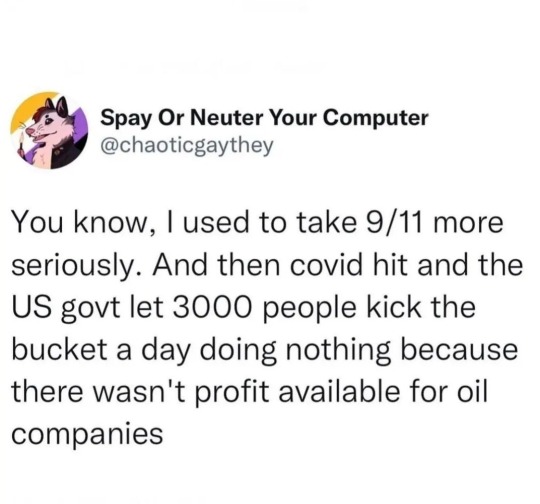
no caption needed
88K notes
·
View notes
Text
How Spotify Tools Are Revolutionizing Music Careers
The digital age has brought incredible opportunities for musicians to expand their reach and connect with fans globally. Among the plethora of platforms available, Spotify stands out as a game-changer. With millions of listeners worldwide, it provides artists with tools to promote their music, engage with fans, and even secure financial support. Let’s explore how tools like Spotify Marquee, Artist Pick, and Fundraising Pick are helping musicians thrive in an ever-competitive industry.
Building Visibility with Spotify Marquee
One of the most effective promotional tools on Spotify is Spotify Marquee. This paid advertising feature targets users who have shown interest in similar music, making it easier for artists to reach potential fans. Unlike traditional ads, Marquee focuses on delivering personalized recommendations, ensuring higher engagement rates.
For instance, if a listener frequently streams indie rock, Marquee will suggest tracks within that genre, increasing the chances of discovery. This precision targeting makes Spotify Marquee a cost-effective tool for independent artists who want to maximize their promotional budget. It’s especially valuable for launching new singles or albums, giving them the push needed to gain traction.
By using this feature, artists can ensure that their music is being heard by people who are more likely to enjoy and follow their work. As the competition on streaming platforms grows, Marquee has become an indispensable part of a musician’s promotional strategy.
The Importance of Keeping Your Artist Pick Updated
A well-maintained Spotify profile is essential for showcasing your brand as an artist, and one of the most prominent features on your page is the Artist Pick section. Learning how to update your artist pick regularly ensures that fans and potential listeners are greeted with your latest releases, favorite playlists, or upcoming gigs.
Imagine a fan visiting your profile to explore your music and seeing an outdated track or event from months ago. This not only misses an opportunity to direct them to your newest work but can also leave a negative impression. Regular updates demonstrate activity and engagement, keeping fans intrigued and excited about your career.
The Artist Pick section can also be used creatively. Highlight collaborations, feature playlists that inspired your music, or even promote a cause close to your heart. It’s a versatile feature that acts as a direct line of communication with your audience, making them feel more connected to you.
Gaining Direct Fan Support Through Fundraising
The rise of streaming platforms has changed how musicians earn revenue. While streams contribute to income, they often don’t match the earnings from live performances. This is where the Spotify Artist Fundraising Pick comes in as a lifeline.
This tool allows artists to display a donation link on their profiles, enabling fans to contribute directly. Whether you’re raising funds for a new album, a tour, or personal challenges, this feature provides a transparent and accessible way for fans to support your journey.
During the pandemic, many musicians used the Fundraising Pick to sustain their careers when live shows were canceled. It demonstrated the power of community, with fans stepping up to help their favorite artists. Even in normal times, it remains an excellent way to finance creative projects and stay connected with a loyal fan base.
Amplify Engagement Through Public Domain Music
While Spotify is often associated with new and original music, artists can also leverage public domain music to expand their repertoire. These compositions, free of copyright restrictions, allow musicians to reinterpret classics or incorporate timeless melodies into their work without legal complications.
Using public domain music can open doors to new audiences, particularly when reimagining popular works. A classical piece with a modern twist, for example, can attract listeners who appreciate innovation while respecting tradition. These tracks can be promoted effectively through Spotify’s tools, ensuring that even non-original compositions receive the recognition they deserve.
Public domain music also provides an opportunity for collaboration. Working with other artists to create new versions of well-known songs can lead to creative breakthroughs and increased exposure for everyone involved.
Leveraging Spotify Marquee for Collaborative Efforts
Collaboration is a powerful way to grow your audience, and Spotify Marquee plays a crucial role in promoting such projects. When two or more artists come together, their combined fan bases create a larger pool of potential listeners. Marquee’s targeting ensures that the collaboration reaches not just existing fans but also new listeners who enjoy similar music.
For example, if an indie pop artist collaborates with an electronic music producer, Marquee can target fans of both genres, increasing the visibility of their joint project. This cross-genre promotion is particularly useful in today’s music landscape, where hybrid styles are gaining popularity.
Additionally, collaborations can be highlighted in the Artist Pick section, drawing attention to these partnerships. Updating the pick with the latest collaboration ensures that it gets the prominence it deserves, helping both artists grow their following.
Conclusion
Spotify has revolutionized the way musicians connect with their audience, offering tools that cater to every stage of a music career. From Spotify Marquee to updating your artist pick and leveraging the Spotify Artist Fundraising Pick, these features empower artists to enhance visibility, engage with fans, and sustain their careers.
Incorporating resources like public domain music further broadens creative horizons, while Marquee amplifies promotional efforts. By utilizing these tools effectively, musicians can stay ahead in a rapidly changing industry and ensure their art reaches those who appreciate it most.
What’s your favorite Spotify tool for growing your career? Share your thoughts and experiences in the comments below!
0 notes